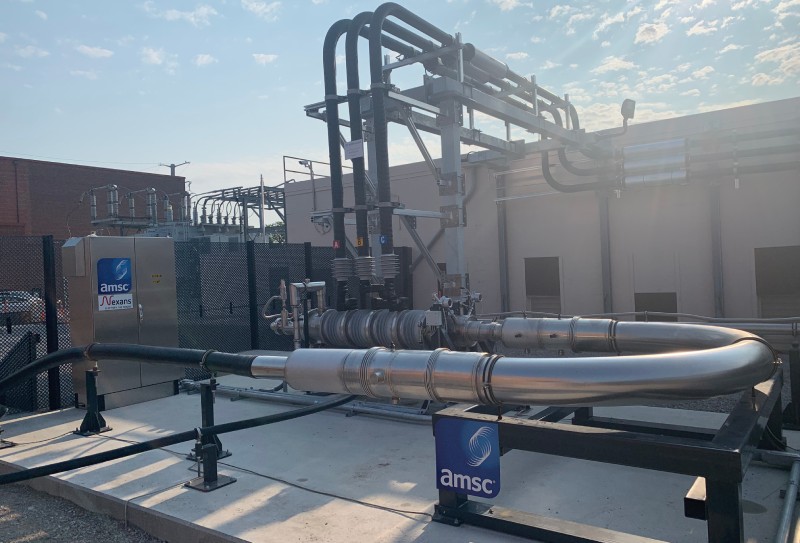Context
RTE France has awarded Nexans a €115 million contract to supply and install power export cables for the Saint Brieuc offshore wind farm. This project, developed by the Ailes Marines Consortium, is a pivotal component of France’s renewable energy strategy, aiming to meet the electricity demands of over 835,000 homes while advancing climate change goals.
Challenges
Started in 2021, the project faces challenges in designing, laying, and maintaining the extensive offshore and onshore cable infrastructure necessary to connect the wind farm to the grid. Additionally, ensuring reliability and efficiency amidst the harsh marine environment presents a significant technical challenge.
496 MW
generated by wind turbines
225 kV
maximum voltage
835,000
homes provided with
energy from this wind farm
67 km
of offshore cables
93 km
of onshore cables
Nexans’ implication
Nexans delivered innovative solutions for both offshore and onshore cable needs. For the submarine cables, Nexans supplied two lengths of 33.5 km 225 kV 3-core cable with an innovative hybrid armoring solution, manufactured in our Halden facility, in Norway. The cable also features a fiber optic element, supplied by our Norway plant in Rognan, for remote health monitoring of the cable link and transmission of information between the offshore wind farm and land base. Cables were installed by Nexans’ own cable-laying vessel, the CS Skagerrak, while the specialized Capjet system has been used to trench the cables into the seabed for protection. Nexans also provides Inspection, Maintenance, and Repair (IMR) services, ensuring the longevity and reliability of the offshore transmission system.
The land cables include 93 km of 225 kV single-core cable, manufactured in our Charleroi facility in Belgium, similar to those provided to RTE by Nexans under the current land cables framework agreement.
This project will be the first offshore connection developed by Nexans for RTE. As such, RTE expects this project to be successful as well as to mark the beginning of a fruitful relationship.
Marine Activities Director, RTE
Nexans’ involvement extends from manufacturing at their facilities in Norway and Belgium to cable laying with their specialized vessel. Laurent Guillaumin, Business Development Director – Offshore Wind Europe, emphasized, ” We are delighted to be working with RTE to provide the grid connection for one of France’s most significant offshore wind projects. The key to this success was our long track record in this sector combined with our ability to offer innovative cable solutions.”
As of spring 2024, the Saint Brieuc offshore wind project is progressing towards commissioning, with Nexans playing a crucial role in ensuring the timely and successful completion of the grid connection. The progressive commissioning marks a significant milestone in France’s renewable energy transition, bringing the nation closer to its ambitious climate targets.

Context
In June 2022, Nexans, in collaboration with SNCF Réseau and with support from Bpifrance, embarked on an innovative project aimed at enhancing the power supply infrastructure at Montparnasse train station in Paris, France. The project responds to the increasing demands on the railway network, necessitating a robust and efficient electrical system to support the growing rail traffic in one of Europe’s busiest transportation hubs.
Montparnasse station, established in 1840, ranks as France’s fourth-largest train station, serving over 50 million passengers annually with an expected surge to 90 million by 2030. The installation of superconducting cables aims to meet the escalating power demands imposed by this anticipated growth in rail traffic.
Challenges
The project faces several significant challenges, foremost among them being the need to upgrade the power supply infrastructure while minimizing disruptions to ongoing rail and road operations. The unique solution to this challenge lies in the utilization of superconducting cables, which will be integrated into Montparnasse station’s existing conduits. This approach presents engineering complexities, as it requires precise coordination to install the new cables within the confines of the pre-existing infrastructure without disrupting the station’s operations. Additionally, ensuring compatibility between the superconducting cables and the existing conduits poses technical challenges that demand meticulous planning and execution.
Key figures
+50 million
passengers annually, expected surge to 90 million passengers by 2030.
5.3 MW
per conduit
3,500 A
to 1,500 VDC
Nexans implication
Nexans plays a pivotal role in the project, drawing on its experience in superconductor technology and electrical infrastructure. The Group is tasked with designing and manufacturing the superconducting cables, as well as coordinating their installation within the existing conduits at Montparnasse station. Only a superconducting cable can combine a reduced diameter and exceptional power to deliver the performance required by SNCF Réseau: 5.3 MW per conduit, or 3,500 A to 1,500 VDC.
Superconducting power cables offer unparalleled advantages. As they have zero resistance, they transport electricity with minimal power loss and thus contribute to making the world more sustainable. This project illustrates perfectly how their compact nature enables them to transport very high power through a limited space. A single superconducting cable can replace multiple copper cables. Also, it has a minimal footprint, making high-capacity 1,500 V connections possible, which in turn improves the safety of the stations’ power supply.
Two cables connecting the Vouillé substation to the overhead lines of the tracks serving Montparnasse were pulled in the existing conduits in 2023. The main stages of this project are the design and manufacturing of the Nexans components in Bourg-en-Bresse, Calais and Hanover for a prototype loop (cable, joint, terminations) which have been tested in the SNCF Test laboratory in Vitry-sur-Seine, followed by the manufacturing of the two cables and their installation in the existing conduits.
This is a world-first that we are proud of and happy to be bringing to life with the SNCF Réseau following a productive partnership. Superconducting cables offer commercial solutions to strengthen high power electrical networks in all urban areas around the world. They are part of a technology of the future developed by Nexans and offer an extremely efficient solution benefiting companies and the general public.

CEO, Nexans
SNCF Réseau is delighted to be able to innovate and benefit from Nexans’ expertise to modernize and strengthen the electricity supply to the major train stations, allowing us to secure and improve the service provided to our customers. Developing this superconducting cable technology should enable us to achieve cost and deadline reductions. Likewise, it is proof of our teams’ know-how. We also thank Bpifrance for its financial support!
Deputy General Manager of Industrial Projects & Engineering, SNCF Réseau
The installation of superconducting cables at Montparnasse station represents a pioneering effort in enhancing the sustainability, reliability, and efficiency of railway power supply systems. Nexans’ involvement underscores its commitment to driving innovation in electrification and contributing to global sustainable development efforts.
Context
In 2022, Nexans has been awarded the contract for the Celtic Interconnector, a groundbreaking project jointly developed by the Irish and French Transmission System Operators, EirGrid and RTE (Réseau de Transport d’Electricité). This project marks a significant milestone as it involves the construction of the world’s longest XLPE interconnector, facilitating direct electricity exchange between France and Ireland for the first time.
Recognized as a Project of Common Interest (PCI) by the European Union, the Celtic Interconnector holds immense importance in the integration of energy systems across Europe. With a capacity of 700 MW, it is poised to supply power to approximately 450,000 homes, contributing significantly to the European energy transition and the achievement of energy policy and climate objectives.
Challenges
The challenges inherent in the Celtic Interconnector project are substantial. Notably, the installation of a 500km subsea cable route, coupled with 40km of underground route in France (Brittany) and 35km in Ireland (Cork County), requires meticulous planning and execution. Additionally, ensuring the highest installation and protection delivery standards poses a significant challenge, especially given the project’s scale and complexity.
Key Figures
700 MW
total capacity
1,000 km
of subsea cables
180 km
of underground cables
Approximately
450K
homes supplied
Nexans implication
Nexans’ involvement in the Celtic Interconnector project is multifaceted and crucial to its success. The company is responsible for manufacturing the cables at its state-of-the-art facilities, including the production of 1,000km of subsea cables in Halden, Norway, and 180km of underground cables in Charleroi, Belgium. The 400 kV HVAC 10km connection to the Irish grid is also part of the project awarded to Nexans. Furthermore, Nexans will manufacture accessories in Cortaillod, Switzerland, and leverage its proven project delivery model and cutting-edge assets, such as the Nexans Aurora Cable Laying Vessel, to ensure the highest installation standards.
A notable aspect of Nexans’ contribution is the implementation of innovative technologies, such as the bundle lay of the two HVDC power cables and a full data capacity repeated fiber optic system. This underscores Nexans’ commitment to pushing the boundaries of technological advancement in the energy sector.
Signing the contract for the Celtic Interconnector further cements Nexans as a major player in renewable energy. We are proud to contribute to such a historic project that works directly with the European Union’s goal of electrical solidarity between Member States. Nexans is leading the way in connecting the parts of the world with the highest renewable energy potential to the parts of the world with the greatest demand for electricity. From energy generation and transmission to distribution and usages, Nexans’ solutions cover the full electrification value chain to ensure electricity can be delivered to all corners of the world securely, reliably, and efficiently.

CEO, Nexans
Expected to be completed and energized by 2026, the Celtic Interconnector represents a significant step forward in Nexans’ journey towards becoming a pure electrification player. By leveraging its expertise and innovative solutions, Nexans is not only advancing the transition to renewable energy but also solidifying its position as a leader in the electrification sector.

Context
Colbún’s Horizonte wind farm stands as a beacon of renewable energy advancement in Latin America, boasting an impressive installed capacity of 778 MW. This project, situated in the municipality of Taltal, Antofagasta Region (Chile), not only marks the largest onshore wind farm under construction in the region but also ranks among the world’s highest installed capacities. It is anticipated to produce 2,400 GWh per year, equivalent to powering over 700 thousand homes annually. The endeavor aligns with global efforts to combat climate change by reducing CO2 emissions by 1.2 million tons annually. Scheduled for completion in 2024, the Horizonte Project is pivotal in Chile’s pursuit of a carbon-neutral future by 2030.
Challenges
The scale and significance of the Horizonte wind farm project present multifaceted challenges. These include optimizing conductor design to meet the project’s unique requirements, ensuring timely production and delivery of 840 kilometers of electrical conductors, and aligning solutions with sustainability objectives. Moreover, effective collaboration among stakeholders is essential for project success amidst evolving renewable energy landscapes and regulatory frameworks.
778 MW
installed capacity
2,400 GWh
annual generation
700 K
homes powered annually
Nexans implication
Madeco by Nexans plays a pivotal role in advancing the Horizonte wind farm project. Leveraging its expertise in cabling solutions, Nexans supplied 840 kilometers of electrical conductors, predominantly aluminum medium voltage cables. These cables were optimized to meet the project’s specific requirements and produced at Nexans plants in Chile and Peru.
We have worked with Sigdo Koppers and Colbún to find the best solutions, in terms of the of conductors, section and reel design, and thus generate relevant efficiencies that contribute to the success of the project.
Commercial Manager, Nexans in Chile
We are very proud to be part of the largest wind farm under construction in Latin America, and one of the most significant worldwide. Participating and working with the various actors involved in the project reaffirms our commitment to developing renewable energies, both in Chile and in the region, as well as our commitment to supporting the carbon-neutral transition by 2030, thereby ensuring a safer, more sustainable, renewable energy future and, above all, accessible to all.
Vice President for the Andean Region, Nexans

























